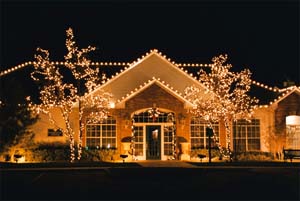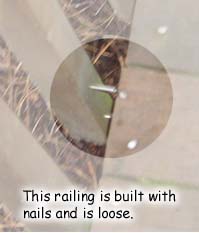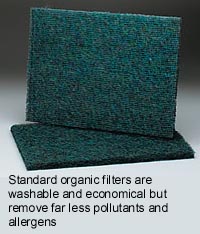 Saving energy in your home will not only save you money, but will also help the environment by reducing the need for hydro-electric dams and fossil fuels used to produce electricity. These steps will pay for themselves again and again for years to come.
Saving energy in your home will not only save you money, but will also help the environment by reducing the need for hydro-electric dams and fossil fuels used to produce electricity. These steps will pay for themselves again and again for years to come.
The average home looses up to 20% of its heating due to drafts. Doors, windows, outlets, and switches are all common areas of heat loss. Most heating bills in our area can be $2000 a season or more meaning those drafts can cost you $400 a year! That buys a lot of weather stripping and caulking. Most doors and windows are easy to check with just your hand, if you feel the cold air coming in then you are loosing heat. Outlets and switches also can be drafty, if you feel cool air around them, consider foam gaskets under the cover plates. Old single pane windows can be made more efficient by installing storm windows or inside magnetic panels to reduce drafts.
Read more on caulk and weather stripping here.

During the day, let the sunlight in to reduce lighting costs, but at sunset, closing curtains will also help reduce heat loss. Consider cellular blinds as they are more energy efficient then blinds and shutters.
Turning down your thermostat by one degree can save over 5 percent on your heating bill.
Consider electronic thermostats with built in timers to reduce energy use when you are at work or sleeping. You can still awaken to a warm house and not use energy when you don't need to. Avoid heating rooms you don't use by closing heat vents or turning down individual room thermostats.
Have your heating system checked regularly to assure that it is running at top efficiency, and always keep air filters clean. A tiny change in a furnace or boiler systems combustion can dramatically lower your heating bills and will often pay for the service call in energy savings.

Water heaters use a lot of energy and should have the thermostats set to 120 degrees. Not only will this save energy, but dramatically reduces the risk of scalding injuries. If it is set higher, you will be using a lot of cold water to bring the temperature down. Gas how water heaters have their thermostat on the exterior and are easy to set, electric heaters are under cover and should be set by a professional.
Read more about energy efficient water heating here.Take showers instead of filling a bath and save about 50% of the energy. Low flow shower heads save both water and energy. If you have a hot tub, make sure the cavity under the tub is insulated and you use a insulated cover. Turn down the heat when you are not going to use it for an extended time.
Lighting is one of the easiest ways to save energy and money. Compact florescent lights (CFLs) are direct replacements for standard incandescent light bulbs. The 100 watt equivalent lights can last 13 times longer and use less then 1/4th the energy. When you buy and install a 6 pack of CFLs, it is like putting $550 in your pocket! They have styles now for replacing bathroom globes and outdoor flood lights. But remember they can't be used with dimmers, and must be disposed of properly. Most hardware stores will take the old lights back.
Computers use significant energy, especially those that are left on all the time. Remember a screensaver saves no energy, but hibernation does, or better yet power them off and save more. Modern LCD displays use 1/3 the energy then a old CRT. Same with most laptops, they are more energy efficient then a standard desktop.
TV's use power all the time, even when they are turned 'off'. Most entertainment devices with remotes (DVD players, VCRs, stereo equipment also use power in standby mode. Unplugging them when you are not using them will save energy.
Keep freezers free from excessive ice buildup. A defrosted freezer is more efficient. Open the doors a minimum amount of time to keep the cold inside. Every time a refrigerator door is opened, the compressor had to re-chill the contents.
Laundry is another big power user, so wash full loads. Use the coolest water temperature that will do the job, and always rinse with cold water. The washing machine itself doesn't use nearly the energy as the water heater does to wash in warm or hot water. The clothes dryer is one of the highest energy use appliance in most homes. Use a clothes line and you will save significant energy.
Look for the "Energy Star" label on all household appliances, and buy the ones with the lowest energy use.
Home without adequate insulation should upgraded. The first place is in the attic, it is cheap and easy to add. The payback in energy savings is very fast since 1/3rd of heat lost is through the roof. If you walls are un-insulated we recommend adding it there too. It will pay you back for as long as you own the home and increase the re-sale value.
1. In unfinished attic spaces, insulate between and over the floor joists to seal off living spaces below.
1A attic access door
2. In finished attic rooms with or without dormer,
insulate …
2A between the studs of "knee" walls;
2B between the studs and rafters of exterior walls and roof;
2C ceilings with cold spaces above;
2D extend insulation into joist space to reduce air flows.
3. All exterior walls, including …
3A walls between living spaces and unheated garages, shed roofs, or storage areas;
3B foundation walls above ground level;
3C foundation walls in heated basements, full wall either interior or exterior.
4. Floors above cold spaces, such as vented craw spaces and unheated garages. Also insulate …
4A any portion of the floor in a room that is cantilevered beyond the exterior wall below;
4B slab floors built directly on the ground;
4C as an alternative to floor insulation, foundation walls of un-vented crawl spaces;
4D extend insulation into joist space to reduce air flows.
5. Band joists.
6. Replacement or storm windows and caulk and seal around all windows and doors.

If you find this information useful, don't keep us a secret! List us on any of your favorite networking / bookmarking sites

 Saving energy in your home will not only save you money, but will also help the environment by reducing the need for hydro-electric dams and fossil fuels used to produce electricity. These steps will pay for themselves again and again for years to come.
Saving energy in your home will not only save you money, but will also help the environment by reducing the need for hydro-electric dams and fossil fuels used to produce electricity. These steps will pay for themselves again and again for years to come.  During the day, let the sunlight in to reduce lighting costs, but at sunset, closing curtains will also help reduce heat loss. Consider cellular blinds as they are more energy efficient then blinds and shutters.
During the day, let the sunlight in to reduce lighting costs, but at sunset, closing curtains will also help reduce heat loss. Consider cellular blinds as they are more energy efficient then blinds and shutters. Water heaters use a lot of energy and should have the thermostats set to 120 degrees. Not only will this save energy, but dramatically reduces the risk of scalding injuries. If it is set higher, you will be using a lot of cold water to bring the temperature down. Gas how water heaters have their thermostat on the exterior and are easy to set, electric heaters are under cover and should be set by a professional. Read more about energy efficient water heating here.
Water heaters use a lot of energy and should have the thermostats set to 120 degrees. Not only will this save energy, but dramatically reduces the risk of scalding injuries. If it is set higher, you will be using a lot of cold water to bring the temperature down. Gas how water heaters have their thermostat on the exterior and are easy to set, electric heaters are under cover and should be set by a professional. Read more about energy efficient water heating here.


 Holiday lighting is a wonderful tradition, and these tips will help to keep you and your family safe.
Holiday lighting is a wonderful tradition, and these tips will help to keep you and your family safe.
 Be careful when hanging lights. Loose wiring is more easily damaged by movement from trees and wind. Never use standard staples, as they can cut into insulation and cause a short or shock hazard. Best to use insulated clips to hang lighting.
Be careful when hanging lights. Loose wiring is more easily damaged by movement from trees and wind. Never use standard staples, as they can cut into insulation and cause a short or shock hazard. Best to use insulated clips to hang lighting.  GFCI protected outlets are recommended for all outdoor electrical use. They dramatically reduce the risk of electrical shocks and electrocutions.
GFCI protected outlets are recommended for all outdoor electrical use. They dramatically reduce the risk of electrical shocks and electrocutions.
 All non frost free hose bibs should be insulated to protect them from freezing. Be sure to disconnect hoses! A hose will cause a frost free hose bib to freeze when the water in the hose freezes.
All non frost free hose bibs should be insulated to protect them from freezing. Be sure to disconnect hoses! A hose will cause a frost free hose bib to freeze when the water in the hose freezes. 


 Every summer there are a spike of fall injuries of children when we open windows up to let fresh air in. Window screens have warnings on then informing consumers that the they are not to be considered fall safety devices. Most screens will come dislodged or tear with only moderate pressure. The view and fresh air are very appealing to young children.
Every summer there are a spike of fall injuries of children when we open windows up to let fresh air in. Window screens have warnings on then informing consumers that the they are not to be considered fall safety devices. Most screens will come dislodged or tear with only moderate pressure. The view and fresh air are very appealing to young children. 



 Fan forced furnaces:
Fan forced furnaces: Keep the filters clean, replacing them every 60 to 90 days. High efficiency air filters will capture up to 30 time more pollutants then standard filters. The spun organic/fiberglass filters are the poorest choice, so avoid the reusable washable types. If you do not have a fan forced furnace, you might consider using a portable air cleaner. The units have a huge range in costs and effectiveness, read more about
Keep the filters clean, replacing them every 60 to 90 days. High efficiency air filters will capture up to 30 time more pollutants then standard filters. The spun organic/fiberglass filters are the poorest choice, so avoid the reusable washable types. If you do not have a fan forced furnace, you might consider using a portable air cleaner. The units have a huge range in costs and effectiveness, read more about  keeping crawlspace moisture low. Beside health issues, excessive moisture in crawlspaces is a conducive condition to wood destroying organisms. If you have combustion appliances, check the air intake vents to assure they are not clogged. Hot water heaters, furnaces, gas stoves etc are possible sources of carbon monoxide without a good supply of fresh air. The American Lung Association recommends annual service of all combustion appliances. At a minimum install
keeping crawlspace moisture low. Beside health issues, excessive moisture in crawlspaces is a conducive condition to wood destroying organisms. If you have combustion appliances, check the air intake vents to assure they are not clogged. Hot water heaters, furnaces, gas stoves etc are possible sources of carbon monoxide without a good supply of fresh air. The American Lung Association recommends annual service of all combustion appliances. At a minimum install 
